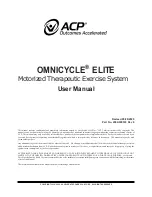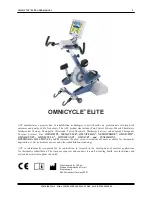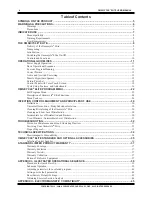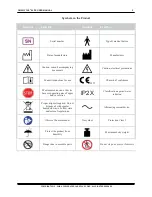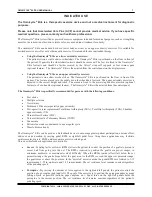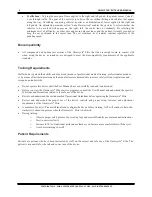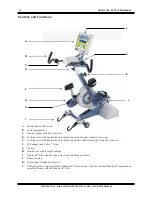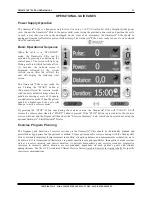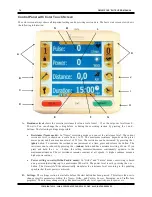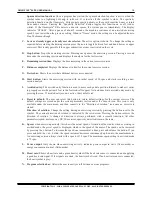
COPYRIGHT 2010 - 2020, ACCELERATED CARE PLUS CORP., ALL RIGHTS RESERVED
12
OMNICYCLE
®
ELITE USER MANUAL
Correct Posture
Always make sure that the patient’s posture is optimized when exercising with the Omnicycle
®
Elite. The greater the
distance between the Omnicycle
®
Elite and the patient’s chair/wheelchair, the more the knee and hip or elbow and
shoulder joints are stretched. This is particularly important in instances where the patient is recovering from
fractures of the hip, or a recent total hip/total knee procedure has occurred. Therefore, you should start the exercise
program with the Omnicycle
®
Elite positioned at the appropriate distance from the patient’s chair/wheelchair to
ensure comfortable range of motion.
Active and Assisted Exercising
“Assisted”
exercising means that the patient’s limbs are moved by the Omnicycle
®
Elite without any effort on the
part of the patient. The movement is provided by the Omnicycle
®
Elite’s “motor-assist” capabilities. When first
powered “ON”, the Omnicycle
®
Elite will always default to an assisted exercising phase with a preset resistance and
speed. When the patient starts exercising more actively on their own with the same motion, the Omnicycle
®
Elite
automatically transitions to more of an “active” exercising mode using less of the system’s “motor-assist” function.
“Active”
exercising means that the patient uses his/her own efforts and energy to turn the machine’s cranks against
a set resistance level. There are several different ways in which the patient can set up the machine for active
exercising:
•
Set resistance:
the patient exercises against a set resistance level which does not change with speed.
•
Set power:
the patient works at a constant power output level (measured in watts). The resistance is
automatically adjusted and stays constant at any pedaling speed. The resistance varies according to the
pedal RPM.
•
Heart rate limit:
the patient exercises at a constant power until the heart rate limit is reached. If the
patient’s heart rate rises above the set limit, the resistance is automatically lowered.
Muscle Hypertonia/Spasms
Muscle hypertonia can be effectively reduced by gentle and even movement on the Omnicycle
®
Elite. The distance
between the Omnicycle
®
Elite and the patient’s chair/wheelchair should be minimized to reduce spasticity. If this is
combined with an upright sitting position and a short crank length, a reduction in the muscle hypertonia and
spasticity can be observed within a short time. This effect may last for several hours past treatment.
The exercise program should be established so as to achieve the correct “degree” of hypertonia reduction. If a
spasm occurs while exercising, the electronic circuitry of the Omnicycle
®
Elite detects it and immediately stops the
motor – assuming the anti-spasm function has been activated (factory setting). The type of spasm suffered by most
patients is an “extension spasm”. On occurrence of an extension spasm, the Omnicycle
®
Elite stops and then
continues to rotate forward after a short delay. That forward rotation stretches the muscles and allows the spasm to
recede. In the event of the less common type of spasm, the “flexion spasm,” the Omnicycle
®
Elite rotates backward
after a spasm occurs.
Cardio-Pulse Set
The Omnicycle
®
Elite has an embedded heart rate sensor that works with Polar
®
products (Cardio-Pulse set), which
measures the heart rate accurately and can be used to track patient progress. Slightly moisten the inside of the chest
band and strap it around the chest (close to the heart) so that the pads come in contact with the patient’s skin, and the
transmitter is facing towards the Omnicycle
®
Elite.
The supplied Polar
®
heart sensor uses a chest strap sensor that should be positioned on the patient’s chest below the
pectoral muscles. This is where the signal is the strongest. The type of ECG signal slightly varies from person to
person. The ECG signal strength can depend on chest form, the anatomical location and position of the heart,
position of the electrodes, and the amount of body fat.

